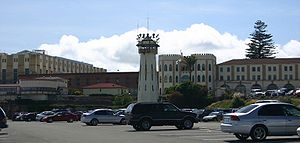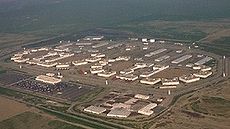
Prisons in California
Encyclopedia

California Department of Corrections and Rehabilitation
The California Department of Corrections and Rehabilitation is responsible for the operation of the California state prison and parole systems. CDC&R is the second largest law enforcement or police agency in the United States behind the New York City Police Department which employs approximately...
Division of Adult Institutions. which had 170,588 inmates as of 2007 - 475 inmates per 100,000 state residents), has been the focus of attention for growing influence upon the state's political arena. Former Governor Gray Davis
Gray Davis
Joseph Graham "Gray" Davis, Jr. is an American Democratic politician who served as California's 37th Governor from 1999 until being recalled in 2003...
was accused of favoring the prison guard union more than the interests of education. Allegations of prisoner abuse gave rise to increased attention of the prison oversight committees. Accusations of police guard favoritism by these committees have occurred as well.
Background
The California system has been the origin of many trends in prison conditions within the United States as a whole. The state's large and diverse population, large size, large urban areas, history of gangGang
A gang is a group of people who, through the organization, formation, and establishment of an assemblage, share a common identity. In current usage it typically denotes a criminal organization or else a criminal affiliation. In early usage, the word gang referred to a group of workmen...
and drug-related crime
Drug-Related Crime
In the United States, Illegal drugs are related to crime in multiple ways. Most directly, it is a crime to use, possess, manufacture, or distribute drugs classified as having a potential for abuse...
, tough sentencing laws and its status as an entry point to the U.S. for both immigrants and drugs has given California a large and complex prison environment. As of November 14, 2011 the California prison system held 143,643 prisoners in state prisons designed to hold 84,130, 1,439 prisoners in in-state contract beds, and 9,439 prisoners held in private, out-of-state prisons. California prisons are overcrowded
Overpopulation
Overpopulation is a condition where an organism's numbers exceed the carrying capacity of its habitat. The term often refers to the relationship between the human population and its environment, the Earth...
, with a number of facilities holding more than 200% of their design capacity.
The system, like the state as a whole, lacks a racial/ethnic majority among the population, with Hispanic inmates making up approximately 37% of the population, African American
African American
African Americans are citizens or residents of the United States who have at least partial ancestry from any of the native populations of Sub-Saharan Africa and are the direct descendants of enslaved Africans within the boundaries of the present United States...
and white
White American
White Americans are people of the United States who are considered or consider themselves White. The United States Census Bureau defines White people as those "having origins in any of the original peoples of Europe, the Middle East, or North Africa...
inmates each representing about 27%, and other inmates representing 8% as of 2006. Prisoner identification and affiliation is tied closely to race and region of the state, which has contributed to tension and violence within the system. There has been a long running racial tension between African American and Southern Mexican American prison gangs and significant riots in California prisons where Mexican inmates and African Americans have targeted each other particularly, based on racial reasons. California is the birthplace of many of the country's most powerful and best-known prison gangs, such as the Aryan Brotherhood
Aryan Brotherhood
The Aryan Brotherhood, also known as The Brand, the AB, or the One-Two, is a white supremacist prison gang and organized crime syndicate in the United States with about 20,000 members in and out of prison...
, the Nuestra Familia
Nuestra Familia
Nuestra Familia is a criminal organization of Mexican American prison gangs with origins in Northern California. While members of the Norteños gang are considered to be affiliated with Nuestra Familia, being a member of Nuestra Familia itself does not signify association as a Norteño...
(which is a branch of the Nortenos which allies with African American gangs), Surenos 13 that branch of another powerful and best-known prison gang the Mexican Mafia
Mexican Mafia
The Mexican Mafia , also known as La Eme , 13 is a Mexican American criminal organization, and is one of the oldest and most powerful prison gangs in the United States.-Foundation:...
. State efforts against these gangs made California a pioneer in the development of Security Housing Unit "supermax" control-unit facilities.
The overcrowded conditions and accusations of inadequate medical facilities and mistreatment have caused the federal courts to intervene in the system's operation since the 1990s, appointing special oversight and enforcing consent decrees over the system's medical system and the SHU units and capping populations at several facilities. As of 2007, the state has plans to continue to expand the system and to involuntarily transfer inmates to other states or federal prisons. Also as of 2007, by order of federal courts, the system's medical system is under federal receivership
Receivership
In law, receivership is the situation in which an institution or enterprise is being held by a receiver, a person "placed in the custodial responsibility for the property of others, including tangible and intangible assets and rights." The receivership remedy is an equitable remedy that emerged in...
, and a federal court may impose a mandatory limit on the system's total population by June 2007.
Prison growth and overcrowding

Prison
A prison is a place in which people are physically confined and, usually, deprived of a range of personal freedoms. Imprisonment or incarceration is a legal penalty that may be imposed by the state for the commission of a crime...
population increased 500%. To accommodate this population growth and the war on crime, the state of California built 23 new prisons at a cost of 280 million to 350 million dollars apiece. By way of comparison, during the 112-year-long period between 1852 and 1964, the state of California had constructed just 12 prisons. California's prisons are public and are financed by the Public Works Department and operated by the California Department of Corrections and Rehabilitation
California Department of Corrections and Rehabilitation
The California Department of Corrections and Rehabilitation is responsible for the operation of the California state prison and parole systems. CDC&R is the second largest law enforcement or police agency in the United States behind the New York City Police Department which employs approximately...
. The state funds the prison system's annual costs. In 2005 the state rate of incarceration was 616 per 100,000 adults.
There are many explanations for the prison growth. One is the perceived drug epidemic in the late 1970s and early 1980s, and the presumed consequent threat to public safety. Building more prisons counters this threat with supposed stability. Another explanation is that, during this period, prison sentences increased and minimum sentencing gave lesser crimes longer jail terms. Moreover, unemployment led many citizens to commit property-related crimes, although, ironically, California has a relatively low rate of property crime occurrence compared to other states. In response to the perceived increasing crime rate, the citizens of California passed the Three Strikes Law
Three strikes law
Three strikes laws)"are statutes enacted by state governments in the United States which require the state courts to hand down a mandatory and extended period of incarceration to persons who have been convicted of a serious criminal offense on three or more separate occasions. These statutes became...
, stipulating a life sentence for those who were convicted of three felonies. Government officials, policy advisers and the media tied the public concern over crime to the need for more prisons. Alleged decreases in crime due to such "crackdowns" are unsupported by researchers which note that crime rates have declined across the nation without regard to whether more punitive laws were enacted or not.
Of the 160,000 prisoners in California, two-thirds are African-American and Latino. Approximately 17% were born abroad. Most prisoners come from California's high density population areas, however incarceration rates in less populated areas are higher than from more congested areas. About 62% of inmates in 2005 were sentenced from Southern California. The largest racial group in California prisons was whites from 1980 to 1986, blacks from 1986 to 1992, and Hispanics from 1992 to the present. For more statistical information and tables see http://www.cjcj.org/cpp/ccf_growth.php
The increase in prisons has led to job opportunities for communities in which prisons are located but locals are generally not benefited by these openings as rural areas where these new institutions are built are not populated by people with the skills or education required to be hired in the prisons. Negative impacts of prisons in such areas mainly include the attraction of inmate visitors who are often impoverished and bring little economic consumption to the community. The better paid prison staff generally lives and shops in other areas than where prisons are located. (See LA Times, May 3, 2010.)
The California Prison Industry Authority provides the inmates themselves with productive job opportunities. The inmate work program's main aim is to rehabilitate prisoners and promote their successful re-entry into society after their punishment has been completed. Through the program, approximately 5,900 inmates are given work assignments in 60 different lines of work at 22 California prisons. The goods produced by the inmates are available for local, state, and federal governmental agencies. Prisoners are able to earn between 30 and 95 cents per hour of work.

